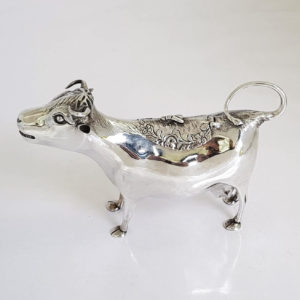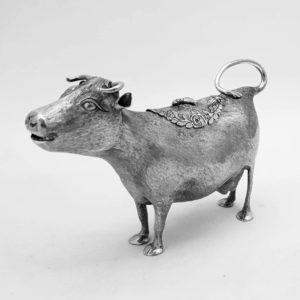John Schuppe
John Schuppe, no record of apprenticeship or freedom, thought to be of immigrant Dutch or German origin. 1st mark as largeworker 1753.
Jugs in the form of standing cows were made in London in some quantity during the second half of the 18th century and most bear the mark of John Schuppe, and were made between 1753 and 1773. Schuppe’s marks are always on the underside of the body in a line, and it is uncommon for the marks to be worn. His mark is occasionally found on small decorative items such as figural tapersticks.
Although Schuppe was the first to make cow creamers from silver, their form is much older. The earliest form was back in 4th century BC Egypt where pottery jugs in the form of cows first appear. They then reappear in early part of the 18th century in Holland. It is from here that Schuppe must have taken his inspiration, and the form which he pioneered was so popular that copies of his style of creamer were made for the next 200 years. One of his cow-shaped creamers (1759-60) is in the collection of the Victoria & Albert Museum, London, with the tail as the handle and a lid on the back with a giant fly on top.
John had two daughters, Mary and Elizabeth, and a son John Schuppe II who was apprenticed in 1770 to the watchmaker Savil Good. John eventually established himself as a silversmith, watchmaker and toyman/dealer in pictures. He died in 1823 aged 60.
John Schuppe
John Schuppe, no record of apprenticeship or freedom, thought to be of immigrant Dutch or German origin. 1st mark as largeworker 1753.
Jugs in the form of standing cows were made in London in some quantity during the second half of the 18th century and most bear the mark of John Schuppe, and were made between 1753 and 1773. Schuppe’s marks are always on the underside of the body in a line, and it is uncommon for the marks to be worn. His mark is occasionally found on small decorative items such as figural tapersticks.
Although Schuppe was the first to make cow creamers from silver, their form is much older. The earliest form was back in 4th century BC Egypt where pottery jugs in the form of cows first appear. They then reappear in early part of the 18th century in Holland. It is from here that Schuppe must have taken his inspiration, and the form which he pioneered was so popular that copies of his style of creamer were made for the next 200 years. One of his cow-shaped creamers (1759-60) is in the collection of the Victoria & Albert Museum, London, with the tail as the handle and a lid on the back with a giant fly on top.
John had two daughters, Mary and Elizabeth, and a son John Schuppe II who was apprenticed in 1770 to the watchmaker Savil Good. John eventually established himself as a silversmith, watchmaker and toyman/dealer in pictures. He died in 1823 aged 60.
-


1765
John Schuppe
9672 George III Silver Cow Creamer
Sold
An antique silver cream jug in the form of a model cow with a handle in the form of a looped tail. The saddle shaped lid on the cow’s back has a finial in the form of a fly; it lifts to fill the jug with cream which is poured out of the cow’s mouth. Simple figuring and naive expressive face. The body has charmingly realistic hair chased on top. Weight 137 grams, 4.4 troy ounces. Length 15cm. Height 9.5cm. London 1765. Maker John Schuppe. Sterling silver.
-


1764
John Schuppe
9934 George III Silver Cow Creamer
Sold
An antique silver cream jug in the form of a model cow. The cavity below the lid is filled with cream which is poured out through the cow’s mouth using the curled tail as a handle. Simple figuring and naive expressive face. The body is all over chased with a charmingly realistic hairy finish. Weight 132 grams, 4.2 troy ounces. Spread 14.5cm. Height 9.5cm (top of horns), 7.6cm (top of back). London 1764. Maker John Schuppe. Sterling silver.